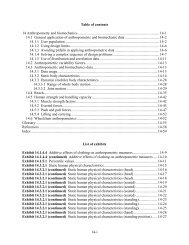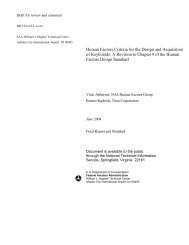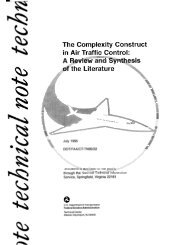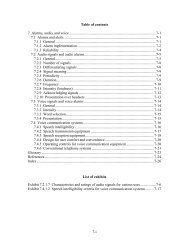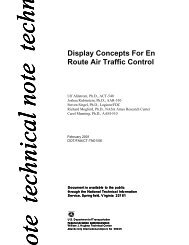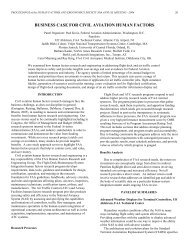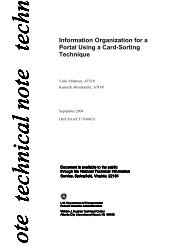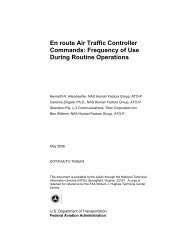Design of information Display Systems for Air Traffic Control - FAA
Design of information Display Systems for Air Traffic Control - FAA
Design of information Display Systems for Air Traffic Control - FAA
You also want an ePaper? Increase the reach of your titles
YUMPU automatically turns print PDFs into web optimized ePapers that Google loves.
specific <strong>in<strong>for</strong>mation</strong>. The En Route IDS (ERIDS) is currently being deployed to the ARTCCs.<br />
All <strong>of</strong> these systems use different design styles, user interaction styles, and customization<br />
capabilities.<br />
Recently, the <strong>Air</strong> <strong>Traffic</strong> Services organization implemented policies to reduce the proliferation<br />
<strong>of</strong> displays and nonstandard systems in the National <strong>Air</strong>space System (NAS). Using an IDS as a<br />
single point <strong>of</strong> access to various tools or sources <strong>of</strong> <strong>in<strong>for</strong>mation</strong> is one means <strong>of</strong> reducing the<br />
number <strong>of</strong> displays in the field. A recent congressional report H.R. Rep. No. 108-243, (2003)<br />
mentioned that future IDS ef<strong>for</strong>ts will require computer-human interface and requirements work<br />
be<strong>for</strong>e the procurement. The standards and guidelines provided in this document will help<br />
ensure that future systems comply with human factors guidelines and meet the needs <strong>of</strong> the users.<br />
1.1 Purpose and Scope<br />
The importance <strong>of</strong> providing good design guidelines <strong>for</strong> system development cannot be<br />
overstated. Without them, there is little likelihood that the system will be effective or easy to<br />
use. Guidelines are <strong>of</strong>ten ignored, however, and when they are used they are <strong>of</strong>ten implemented<br />
incorrectly. To provide effective and useful guidelines, we researched the factors that make<br />
designers more likely to use them and implement them appropriately. In one study, de Souza<br />
and Bevan (1990) asked designers to modify an interface to make it compliant with a set <strong>of</strong><br />
design guidelines. After allowing the designers to modify the interface, they assessed<br />
compliance with the guidelines. They found that compliance was most likely to occur if the<br />
guidelines clearly explained the goals and benefits <strong>of</strong> applying them, the conditions under which<br />
the guidelines should be applied, and clear procedures on how to apply them. Henninger,<br />
Haynes, and Reith (1995) found that useful design guidelines must be focused, targeting design<br />
issues related to a particular user community. They also found that designers were more likely to<br />
use guidelines accompanied by concrete examples, and that the appropriate application <strong>of</strong> design<br />
standards was directly related to understanding the users’ needs. Both groups emphasized the<br />
need <strong>for</strong> design guidelines to focus more clearly on the specific user group <strong>for</strong> which a product is<br />
being designed.<br />
This document describes design standards and guidelines <strong>for</strong> ATC IDSs. We developed the<br />
design standards by studying current IDS use in the field and evaluating existing design<br />
guidelines and standards to identify principles that are particularly important in the design <strong>of</strong><br />
ATC IDSs. We also describe the lessons learned from the successes and problems <strong>of</strong> existing<br />
systems to provide a context <strong>for</strong> the standards. The application <strong>of</strong> these design standards and<br />
guidelines will address the issues <strong>of</strong> proliferation <strong>of</strong> nonstandard systems in the NAS while<br />
providing the user with an IDS optimized to support their <strong>in<strong>for</strong>mation</strong> needs. Furthermore, this<br />
document will serve to consolidate <strong>in<strong>for</strong>mation</strong> on the specialized needs <strong>of</strong> ATC personnel <strong>for</strong><br />
system designers, developers, and others involved with the selection or evaluation <strong>of</strong> an IDS <strong>for</strong><br />
ATC. The system administrators <strong>of</strong> current IDSs can also use this document to improve their<br />
systems.<br />
This document should be used as an aid in the development <strong>of</strong> future IDS systems. The guidance<br />
presented here is not exhaustive in the sense that other, more general human factors design<br />
guidelines still apply. For example, several <strong>of</strong> the guidelines listed here discuss the use <strong>of</strong> labels.<br />
Though they are not covered here, there are human factors design guidelines that recommend<br />
2



